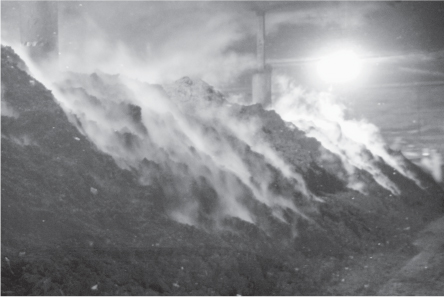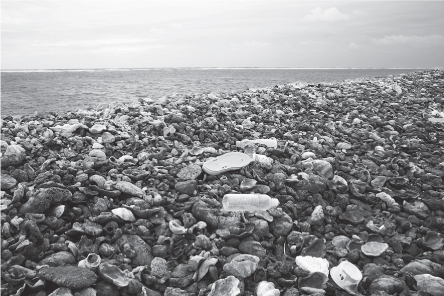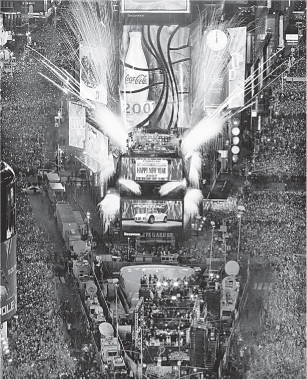Catherine Price (7 page)
Authors: 101 Places Not to See Before You Die

A
ction Park—also known as Traction Park, Class Action Park, and Death Park—was an amusement park in Vernon Township, New Jersey. Responsible for at least six deaths and countless accidents, it inspired so many personal injury lawsuits that in 1996, it was forced to shut down.
The park was built as an off-season moneymaker for the Vernon Valley/Great Gorge ski area, and featured rides so obviously dangerous that they call into question the sanity of the person who designed them. Take, for example, the Alpine Slide. Built into the ski slope, it sent visitors zooming down the hillside on a concrete and fiberglass track in sleds equipped with poorly maintained brakes. There were two speeds available: very slow or extremely fast. Extremely fast meant risking having your sled jump the rails (a frequent occurrence), suffering abrasions and burns when you hit the track, and being hurled into a bale of hay at the bottom of the hill. Very slow, on the other hand, put you in danger of being rear-ended by the extremely fast person behind you. In 1984 and 1985, state records show that the ride resulted in at least fourteen fractures and twenty-six head injuries. It was also responsible for the park’s first death.
But the accidents didn’t stop there. Employees—mostly under twenty years old and often inebriated—souped up the Super Go Karts so that guests could play bumper cars at fifty miles per hour. The Super Speedboats, which visitors often rammed into one another, shared a pond with a healthy population of water snakes. The Tidal Wave Pool—nicknamed the “Grave Pool”—required twelve full-time lifeguards, who reported rescuing as many as thirty people per day on busy summer weekends. The Tarzan Swing dropped people into a pool of water so cold that in 1984, it’s said to have triggered a man’s fatal heart attack. The Aqua Scoot gave people head lacerations. The Diving Cliffs were positioned above a pool whose swimmers didn’t know they existed. The Kayak Experience’s submerged electric fans killed the park’s second victim: a twenty-seven-year-old man who was electrocuted when his boat tipped over and he stepped out to right it.
And then there was the Cannonball Loop slide—an enclosed waterslide that ended with a roller coaster-esque loop-de-loop. Based on the faulty premise that a wet bathing suit would provide the slickness and momentum necessary to carry a person up and around a 360-degree loop, the ride was closed after only a month.
Gone are the days of Action Park’s treacherous rides, untrained employees, and copious beer stands. It’s now the Mountain Creek Waterpark and is, by all accounts, much, much safer. But the morbidly nostalgic can still catch a glimpse of past dangers—underneath the route of the modern-day gondola lies the abandoned track of the Alpine Slide.
I
magine a room filled with human shit—huge, steaming piles of it, arranged in rows in a dimly lit, windowless space the size of a parking garage. Actively rotting, the piles give off a fog so thick that, on particularly humid days, the machinery operators can’t actually see the ground.
Sound appealing? The Inland Empire Regional Composting Authority is the country’s largest indoor composting facility for
biosolids—a fancy word for sewage sludge. Housed in a former Ikea warehouse, the facility gets its raw material from an area in Southern California called the Inland Empire, blends the sludge with wood chips, lets it rot, and sells it as SoilPro, a fertilizer for home gardens.
By the end of its sixty-day journey through the warehouse, microbes have broken the sludge down so thoroughly that it’s recognizable only by a faded manure-like smell and dark brown color. But there is nothing subtle about the process it took to get there. In the main composting room, which is a vast cavern bathed in dim yellow light, mounds of steaming sludge stretch toward the ceiling in piles taller than the trucks that brought them in. A system of powerful fans changes the room’s air twelve times an hour, but the smell is still so strong that stepping out of your car’s protective bubble for even a moment will burn your eyes, turn your stomach, and saturate your clothing with the scent of ammonia and excrement.
A warehouse full of rotting feces. You had me at “Hello.”

Steaming piles of poop
Courtesy of the author
T
here are places you should stay away from because they’re not worth the trouble, and there are places to stay away from because if humans visit, things get screwed up. Kingman Reef qualifies on both counts.
Smack in the middle of the Pacific Ocean, Kingman Reef is about a thousand miles from Honolulu. Technically it’s the northernmost of the Line Islands, but that’s a dubious nomenclature since it’s not actually an island. Above water, Kingman Reef is an uninhabited spit of smashed coral and shells, decorated by occasional pieces of human-made flotsam: plastic bottles, broken bits of Styrofoam, and a shocking number of widowed flip-flops. Its total land area is about 0.01 square miles.
When I visited the reef on a two-week marine biology expedition from the Line Islands to Hawaii, the first thing I noticed as our boat approached was a shipwreck washed up on the spit’s opposite shore. At first this seemed cool—a shipwreck! How fun! Then I remembered that I was on a boat. I also noticed the mood of our captain, who was becoming increasingly nervous as we neared the spit. Unable to drop anchor—he didn’t want to damage any coral—he was guiding us back and forth along a line, motoring the ship a safe distance away from land, killing the engine, letting us drift back toward shore, and then starting the motor again. He did this for sixteen hours.
Meanwhile, the marine biologists in charge of the expedition decided that our proximity to the reef was the perfect occasion for a new evening activity: shark baiting. Who cared that it was beginning to storm? Using the remnants of a tuna they had caught several days before, the crew spent the night dangling chunks of flesh off the side of the boat, tempting sharks—of which there were many—to approach our boat and jump through the horizontal rain as they tried to snap the fish off the line.
By the following morning, the captain’s nerves were shot. He suggested leaving, but the marine biologists had other things in mind. Namely, snorkeling. To avoid tempting the sharks, we went out in large inflatable rafts, leaned out over the edge, and stuck our heads in the water.

Courtesy of the author
Which brings me to the second reason not to visit: Kingman Reef is beautiful. Stick your head underwater and you’ll be treated to the sight of bright corals, giant clams, and countless fish; I even caught sight of a camouflaged octopus hiding in the seaweed. According to marine biologists, Kingman Reef is one of perhaps fifty reefs worldwide that have been preserved in such a pristine condition, free from human interference and pollution. The result is a spectacular sight, but also means that, for the reef’s own sake, we shouldn’t go see it.
D
o your favorite things in the world include fish, seaweed, and sex? Do you love sushi but wish it could be a little rawer?
Then find a restaurant that offers
nyotaimori
. Literally translated as “female body presentation,”
nyotaimori
is colloquially known as “naked sushi”: raw fish served on a nude woman.
After stripping down and shaving off all extraneous body hair, young, nubile models wash themselves in unscented soap, lie down on a table, and allow chefs to cover them in sushi, seaweed, and a few strategically placed flowers. Wheeled into a banquet room, they then spend several hours staring blankly at the ceiling as diners ogle their bodies and poke them with chopsticks. In places with particularly strict hygiene laws—not to mention interesting interpretations of what qualifies as sexy—the models are covered in saran wrap.
To an outsider,
nyotaimori
might just seem like an example of sitophila—the desire to eat foods off another person’s body. But fans insist it’s actually a matter of taste; by sitting for a half hour on a woman’s bare stomach, they explain, your tuna roll is heated to body temperature. According to their logic, this allows its flavors to expand and prevents the unpleasant shock that comes when the fish is too cold. One could argue that since belly buttons are not the most efficient chafers—that’s why God invented heat lamps—the true appeal is less about temperature than titillation. Fair enough, say its fans. Fewer people means a better view.
Nyotaimori
, which started in Japan, has been banned in China for “insult[ing] people’s moral quality.” So instead the phenomenon spread east.
Nyotaimori
bars can be found in cities including Los Angeles, Chicago, New York, and, yes, Minneapolis. Some American bars also offer
nantaimori
: sushi served on a naked man.
But despite its questionable morals and hygiene,
nyotaimori
is not the grossest Japanese food custom out there. That honor goes to
wakame sake
. Translated as seaweed sake, it’s a delicacy where a naked, supine model clamps her thighs together to form a triangular cup. Sake is poured down her body and into the indentation. As it fills, the woman’s pubic hair begins to gently undulate in the warm sake, similar—say the poets—to seaweed swaying in the ocean. Then a drunk businessman leans down and slurps it out of her crotch.
Delicious.
S
ituated on the U.S.-Mexico border in Arizona, Organ Pipe Cactus National Monument is a 330,689-acre piece of the Sonoran Desert best known not just for its wildlife or iconic organ-pipe cacti but for its status as a border crossing for drug traffickers. The U.S. Park Rangers Lodge of the Fraternal Order of Police named Organ Pipe the most dangerous national park in the United States, and
National Geographic
describes it as a place where park rangers “wear camouflage, carry assault rifles, and chase drug smugglers through the blazing desert.” “They’re at the front lines of a violent border war,” says the magazine, “and they’re losing.” In 2002, a twenty-eight-year-old ranger was shot and killed while attempting to help border control agents catch two men suspected in a drug-related quadruple murder, and in 2002, rangers seized 14,000 pounds of pot from the park—a third of the total seized in all national parks and monuments combined.
This doesn’t deter visitors—with up to one thousand guests per night, Organ Pipe leads the national parks in the number of backcountry stays. Granted, most of those visitors have entered the United States illegally through the park’s thirty-one-mile border with Mexico (park rangers advise what to do if you come across people in distress asking for food and water). But if they’re willing to deal with the desert’s 116-degree summer heat, venomous snakes, spiders, scorpions, centipedes, and, of course, drug traffickers, perhaps it’s only fair to let them stay the night.
T
here are only two circumstances where a dropping ball can qualify as a noteworthy event: male adolescence and New Year’s Eve in Times Square. Having had no personal experience with the first, I will instead skip to the second and say that if you value your sanity, your extremities, and your bladder, you should find a different place to celebrate the new year.
The tradition goes back to 1904, when Adolph S. Ochs, owner of the
New York Times
, threw a party on New Year’s Eve to celebrate the opening of the newspaper’s headquarters at what is now One Times Square. With an all-day street festival and a thrilling fireworks display, Ochs’s party was so successful that it quickly became New York’s premier New Year’s Eve party.
The New Year’s ball didn’t come into play till 1907, however, when Ochs commissioned a 700-pound iron-and-wood ball with one hundred 25-watt lightbulbs to be lowered from the tower’s flagpole to celebrate 1908. Since then it’s been replaced several times—1920 introduced a 400-pound ball made of wrought iron; 1955 saw the debut of a 150-pound aluminum sphere. In 1980, red lightbulbs and a stem turned the ball into an apple for the “I Love New York” marketing campaign, and the millennium celebration was graced by a ball made from Waterford Crystal. In 2009, the co-organizers of the celebration unveiled the latest ball: twelve feet in diameter, it’s covered in crystals and more than thirty-two thousand LEDs. At around six tons, it puts previous balls to shame.
But even a six-ton ball is not enough to justify spending your New Year’s Eve in the Square. Back in the good old days, drunken revelers packed themselves behind wooden barriers, partied their hearts out, and then hopped back on the Long Island Railroad. Nowadays the event is heavily guarded by the NYPD, with each partygoer treated as a possible member of Al Qaeda. Backpacks and large bags are forbidden, and every would-be reveler has to pass through a metal detector before being allowed into the Square.
Once inside (and get there early, since people start arriving by midday), you’re stuck: in order to control the crowd and prevent people from pressing to the front, the police herd visitors into metal pens, which they’re not allowed to leave until the clock strikes twelve. If you do desert your fellow livestock partygoers, don’t expect to get back to your original spot—by midnight, the streets are packed to Penn Station, eight blocks away.
And trust me when I say you’ll have plenty of reasons to leave. First, it’s freezing. January in New York is cold, and midnight in January in New York is even colder. The event organizers recommend dressing in heavy layers, but I’d go a step further and suggest wearing everything you own.
It’d be nice if you could warm up with a cup of soup, but don’t get your hopes up: food vendors aren’t allowed in the Square on New Year’s Eve. So unless you packed your pockets with Clif Bars or feel like paying a cover charge at a restaurant (and thus losing your place in the pen), you’re going to be ringing in the new year on an empty stomach.
You’re also going to be celebrating it sober—at the world’s most famous New Year’s party, no alcohol is allowed. Some people choose to booze it up ahead of time—like at 10
A.M.
—but be careful: there are no bathrooms. That’s right. Nearly a million people crowd into Times Square every New Year’s Eve, some of whom arrive twelve hours before the ball drops, and yet the city provides no additional facilities. In the words of a former NYPD cop, if you want to survive New Year’s in Times Square, “you’d better have the bladder of a camel.”
If you are still insistent on spending New Year’s Eve in Times Square (perhaps you are also the sort of person who enjoys spending long periods of time in MRI tubes), then do yourself a favor and get a hotel room with a view of the festivities. It’ll be expensive, and you’ll have to book far in advance, but when you’re standing in your toasty room, champagne glass in hand, looking down at the crowds with a private toilet just steps away, there’ll be no question it was worth it.

Countdown Entertainment, LLC
